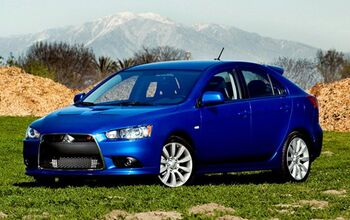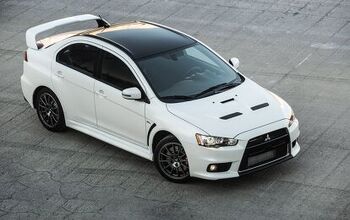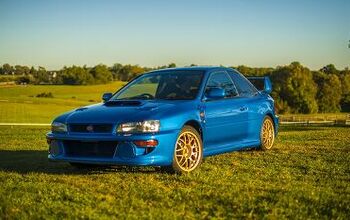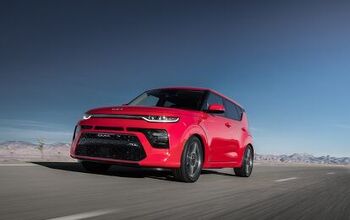2008 Mitsubishi Lancer Evolution 10
The Mitsubishi Lancer Evolution is a pumped up version of the new Lancer. Born out of the original 1981 Mitsubishi Lancer 2000 Turbo rally, 10 generations of high-performance Lancer Evolution models have been sold in Japan, Australia and other Asian markets. It was thrust into limited production out of necessity in order to fulfill the WRCs group A 1992 homologation rules. Since then, poor crash test results and safety concerns kept several generations of the Evo out of North America and off our roads. An insufficient front crumple zone had been a major barrier to getting it over here. Mitsubishi worked on the problem for several years and the first U.S.-spec Evo VIIIs started being sold here five years ago.
FAST FACTS
| 1. |
Mitsubishi offers two version of the Evo, the GSR and MR. |
| 2. |
The GSR gets a five-speed manual and the MR gets a six-speed dual-clutch transmission with paddle shifters. |
| 3. |
The Evo 10 gets a completely new turbocharged 2.0L four-cylinder with 290hp and 300 ft-lbs of torque. |
These problems are no longer around and, since the new Lancer is built on a new global architecture based on the Outlander SUV, all restrictions have been lifted. Now in its 10th edition, the revered Mitsubishi Lancer Evolution is here to stay. Evolution models share the same basic DNA as the current Mitsubishi Lancer models (DE, ES and GTS) released last year. The Evo is just a lot more powerful and fun to drive, which I had several opportunities to do this summer.
BRAND NEW 2.0L TURBO FOUR
Powering the Evo 10 is a brand new engine codenamed 4B11. Gone is the proven 4G63 powerplant that’s graced the engine bays of many previous Evos and Eclipses reliably for many years. Mitsubishi’s Innovative Valve-timing Electronic Control system (MIVEC) sticks around on this all-aluminum intercooled 2.0L turbo inline-four. The new engine is 26.5 lbs lighter than its predecessor and slightly more powerful, making a hair over 290 hp, with 300 ft-lbs of torque peaking just above 4000 rpm.
If you get into one of the eight standard Lancers, you get a 152 hp 2.0L DOHC MIVEC engine, but no turbo. Stepping up to the Lancer Evolution is definitely recommended for people looking for high-performance. Evo pricing is largely dictated by which model you want and there are only two models to pick from.
EVOLUTION GSR GETS FIVE-SPEED MANUAL
The entry-level Evolution GSR, which pays homage to earlier rally car nomenclatures, brings a slick five-speed manual transmission, steering-wheel accessible Super All-Wheel Control (S-AWC) system, 18-inch Enkei cast aluminum wheels, Yokohama Advan Sport tires, Brembo brakes, Recaro seats, dual exhaust, seven airbags (front, side, curtain and driver’s knee), automatic climate control, power windows/mirrors, cruise, fog lights, aluminum pedals and a GTS-style rear spoiler.
With a 59/41 (front/rear) weight distribution, standard aluminum hood, roof and front fenders, Lancer Evolutions ensure the 3,031 lb performance halos center of gravity is lower and far more complaint than standard Lancers.
There are few options for the GSR. There is a sight and sound pack that adds HID headlamps, a large rear spoiler, Rockford Fosgate 6-CD/MP3 sound system with 10-inch subwoofer and Sirius satellite radio compatibility, plus a Fast key entry and start system.
EVOLUTION MR GETS DOUBLE-CLUTCH SIX-SPEED TRANNY
The other version is called the MR and it boasts more convenience and entertainment features on top of an all-new six-speed Twin Clutch Sportronic Shift Transmission (TC-SST) with paddle shifters. This is the only tranny offered on the MR, which also boasts 18-inch forged alloy wheels by BBS, Brembo brakes with two-piece front rotors, uprated suspension bits, leather and more.
The MR edition allows you to opt for a technology pack. This includes a more capable 30GB HDD navigation and music server that replaces the standard audio controls with Rockford Fosgate components and a seven-inch LCD screen.
In both cars, throttle response form the 4B11 is excellent and it feels like you’re being shot into the next corner by a high caliber rifle. The turbo pulls hard from just below 3000 rpm, but it doesn’t jerk the car or upset its balance. Rather, it bolsters the linear power delivery nicely and disguises any turbo lag quite well. First to fourth gears are fairly close together and the car has very little rolling resistance. The pedals could be a bit closer together, but the clutch is firm and responsive and the shifter slides into place effortlessly.
On the flip side, the TC-SST can do all of the shifting for you automatically. Or, the magnesium paddles can be used – either way the twin-clutch already has the next gear pre-selected. This makes the shifts lightning-quick (way faster than the GSR). I prefer that latter for all-around use and the automatic has proven itself worthy on both road and track.
SUPER ALL-WHEEL CONTROL SYSTEM REALLY IS SUPER
Both models have amazing steering that’s lightweight and precise at all speeds. They are extremely responsive and traction is never an issue. Both Evos benefit from Mitsubishi’s Super All-Wheel Control system (S-AWC), which relies on ABS with EBD, plus a number of other sensors and active technologies, to monitor and react to the vehicle and changing road conditions. The Evo’s active center differential (ACD), for instance, automatically manages torque from front to rear while active yaw control (AYC) sends the proper inputs to the left and right. Active stability control (ASC) keeps the car from spinning out while exiting corners and I found the system to be quite transparent. As in, I barely noticed it.
THE VERDICT
PLUS
- Aggressive looks
- Brilliant steering / handling
- Double-clutch tranny makes Evo useable for every-day driving
MINUS
- Five-speed manual and not a six-speed
- Pedals a little far apart
- Manual tranny GSR gets less aggressive suspension and heavier wheels
Both cars are incredibly agile. It simply boils down to your choice of transmission. The five-speed manual is better for someone who wants to race full-time, while the TC-SST offers a more well-rounded package for daily-driving. Don’t mistake this statement to mean the double-clutch MR isn’t good at the track though, because that’s simply not the case. Both are equally capable at the track and the double-clutch MR has the added benefit of being civilized (or perhaps just more civilized) around town.
A detuned RalliArt edition, which will sit between the standard Lancers and Evo models, will further increase the number of Lancer trims in 2009. On or off the track, the 2008 Lancer Evolution will resonate with customers on two fronts: performance and design. The car goes, and goes fast. Plus, it looks ferocious. Next to the Nissan GT-R, the Evo was the most fun I’ve had in a car this year. It’s that good!
More by Shaun Keenan































Comments
Join the conversation